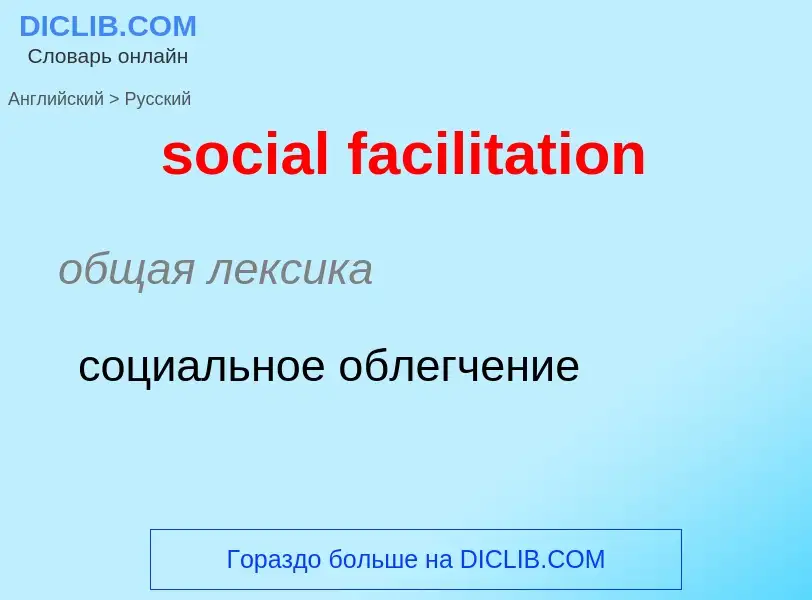Translation and analysis of words by ChatGPT artificial intelligence
On this page you can get a detailed analysis of a word or phrase, produced by the best artificial intelligence technology to date:
- how the word is used
- frequency of use
- it is used more often in oral or written speech
- word translation options
- usage examples (several phrases with translation)
- etymology
social facilitation - translation to russian
общая лексика
социальное облегчение
[kəu'ækʃ(ə)n]
общая лексика
коакция
совместное действие
обоюдная активность организмов в сообществе
существительное
общая лексика
совместное действие
биология
обоюдная активность организмов в сообществе
Definition
---
(СДПГ) , создана в 1869 на общегерманском рабочем съезде в Эйзенахе (руководители - В. Либкнехт и А. Бебель). В партии шла острая борьба между течениями [с нач. 20 в. три: ревизионистское, или правое (Э. Бернштейн, К. Легин, Ф. Эберт, Ф. Шейдеман, Г. Мюллер), центристское (К. Каутский, после 1910) и левое (К. Либкнехт, Р. Люксембург, К. Цеткин, Ф. Меринг, В. Пик), на основе которого образована в декабре 1918 КПГ. Находилась вне закона в 1878-90 и во время фашистской диктатуры (1933-45).
Wikipedia
Social facilitation is a social phenomenon in which being in the presence of others improves individual task performance. That is, people do better on tasks when they are with other people rather than when they are doing the task alone. Situations that elicit social facilitation include coaction, performing for an audience, and appears to depend on task complexity.
Norman Triplett's early investigations describes social facilitation to occur during instances of coaction, which is performing a task in the presence of other people performing a similar task, while not necessarily engaging in direct interactions with each other. Triplett first observed this in cyclists, finding that cyclists rode at faster speeds when competing against other cyclists compared to when cycling alone. Social facilitation has also been known to occur when performing a task in front of an audience, or during periods of observation, sometimes referred to as audience effects. For instance, during exercise Meumann (1904) found that when being watched, individuals could lift heavier weights compared to when they were not being watched. Research on the effects of coaction and audience effects on social facilitation have been mixed. In an attempt to discover why these types of situations do not always trigger social facilitation, Robert Zajonc (1965) theorized that perhaps task complexity, or how simple versus complex a task is, could influence whether or not social facilitation occurs.
Zajonc predicted that simple tasks would result in social facilitation within group settings, whereas more complicated tasks would not. According to Zajonc, some tasks are easier to learn and perform than others because they require dominant responses. Dominant responses are behavioral responses at the top of an organism's behavioral repertoire, making them more readily available, or 'dominant', above all other responses. Tasks that elicit dominant responses are typically simpler, less effortful, and easier to perform compared to tasks eliciting non-dominant responses. Non-dominant responses are harder to carry out. In sum, simple tasks require dominant responses whereas complex tasks require non-dominant responses. When performing tasks in groups then, simple tasks will be associated with social facilitation. However, complex tasks will not because the presence of others becomes distracting when attempting to elicit non-dominant responses that require more effort to use.
Later research develops the idea of coaction, audience effects, and task complexity. For instance, the Yerkes-Dodson law, when applied to social facilitation, states that "the mere presence of other people will enhance the performance in speed and accuracy of well-practiced tasks, but will degrade in the performance of less familiar tasks." Compared to their performance when alone, when in the presence of others they tend to perform better on simple or well-rehearsed tasks and worse on complex or new ones.
The audience effect attempts to explain psychologically why the presence of an audience leads to people performing tasks better in some cases and worse in others. This idea was further explored when some studies showed that the presence of a passive audience facilitated the better performance of a simple task, while other studies showed that the presence of a passive audience inhibited the performance of a more difficult task or one that was not well practiced, possibly due to psychological pressure or stress. (See Yerkes–Dodson law.)
Many factors contribute to social facilitation, and many theories have been proposed to try to explain the phenomena.

